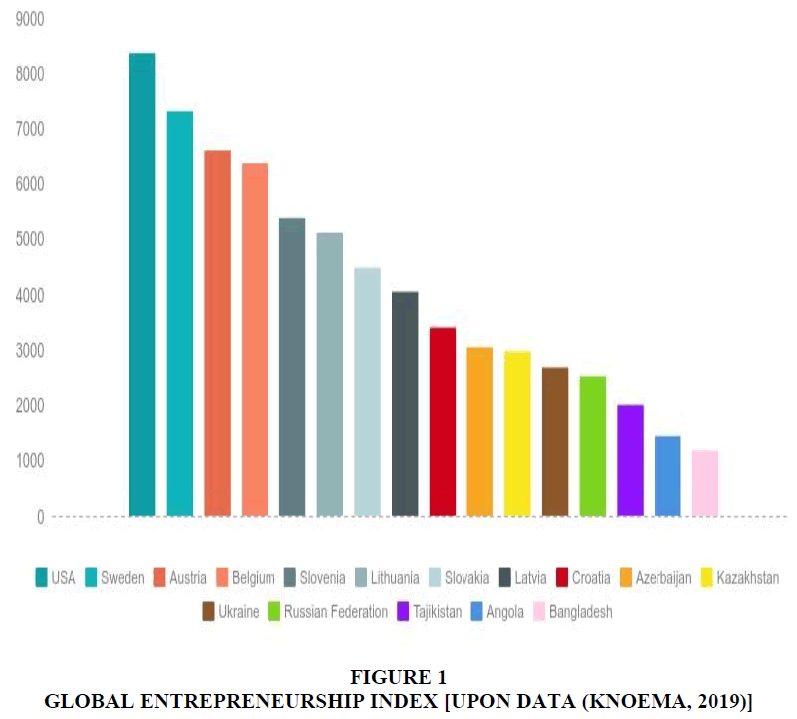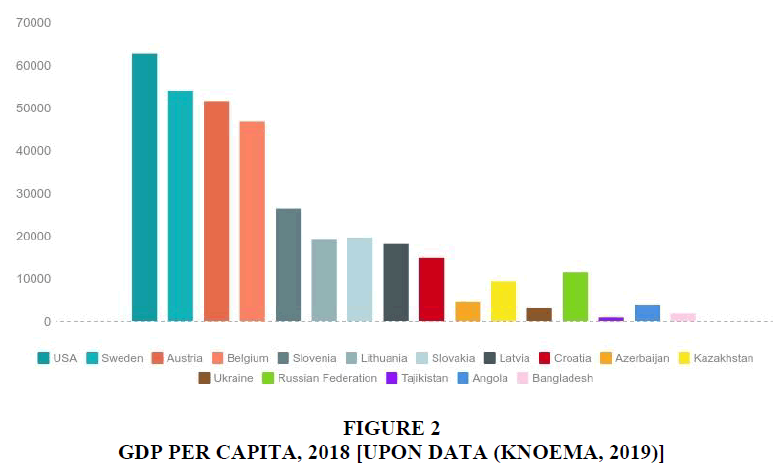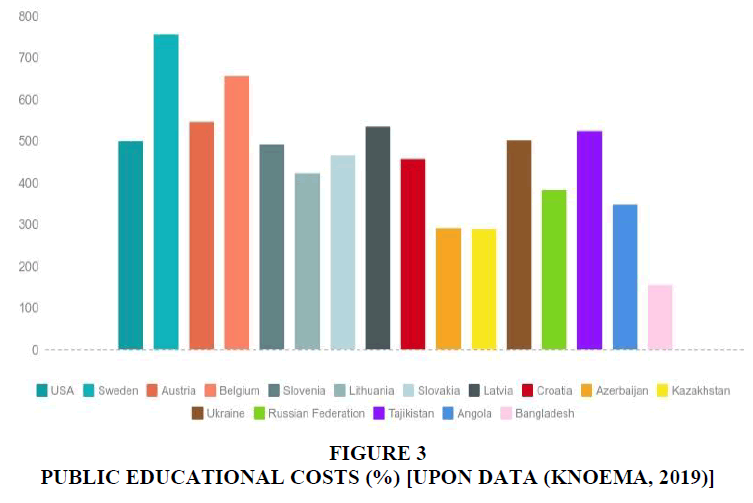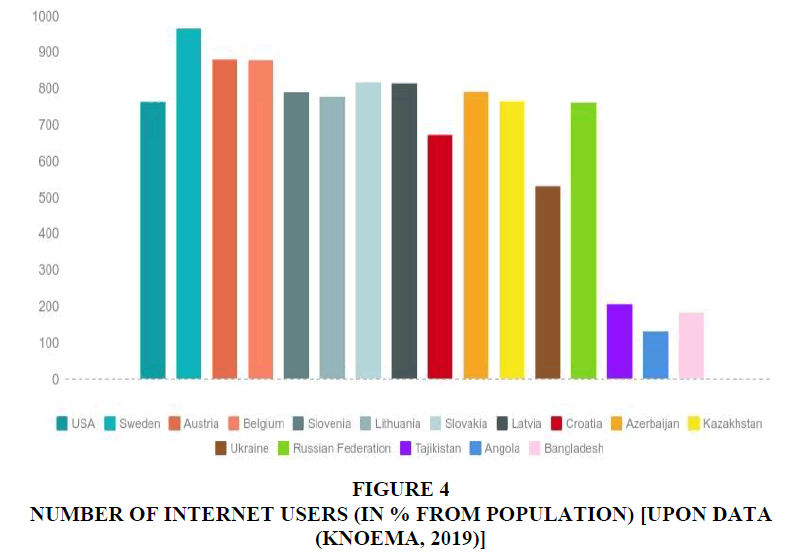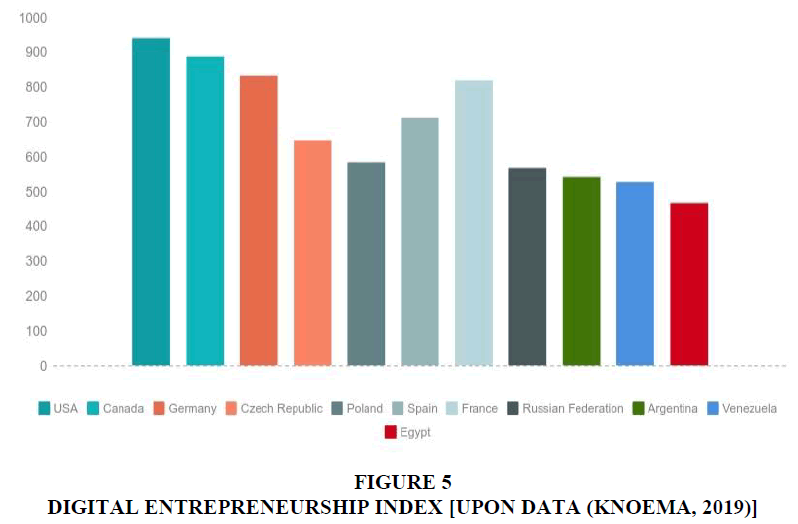Research Article: 2019 Vol: 22 Issue: 4
The Impact of Strategic Outsourcing on the Interaction Market in Entrepreneurship Education
Anastasia Kurilova, Togliatti State University
Ekaterina Lysenko, Taganrog Institute named after A.P. Chekhov (branch)
Rostov State University of Economics (RINH)
Nikolay Pronkin, Sechenov First Moscow State Medical University (Sechenov University)
Kirill Mukhin, The Federal State-Funded Educational Institution of Higher
Education 'Financial University under the Government of the Russian Federation'
Denis Syromyatnikov, North-Caucasus Federal University
Abstract
Entrepreneurship education aims to provide students with the knowledge, skills and motivation to promote entrepreneurial success in various conditions and areas of business activity. The entrepreneurship education focuses on developing skills that enable in future to define and carry out opportunities. It is important to teach entrepreneurship in an interdisciplinary environment to help students cooperating with representatives from different areas and to interact with people of different levels of education and culture. The organization of such learning environment is a difficult and relevant task. Due to digital technologies, future jobs require more and more various skills. Graduates of higher educational institutions need to acquire the right combination of skills for achieving success in a rapidly changing and interconnected world. Today we are witnessing unique development of Internet technologies, which are often ahead of the intellectual capabilities of the mass consumer. That is why e-learning is becoming increasingly relevant and in demand. The need for continuous replenishment and updating of professional knowledge, their actualization at the productive stage of human life is determined by the rate of scientific and technological progress, the transition to the information stage of the development of society, the widespread use of innovative technologies. There is a prerequisite for the formation and development of the category of strategic outsourcing. In contrast to services that are one-time, episodic in nature, the functions of professional support for the uninterrupted operation of individual systems and infrastructure on the basis of a long-term contract are usually transferred to strategic outsourcing. The strategic outsourcing allows not only fundamentally restructuring business processes, but also significantly improving opportunities and perspectives. The objective of this study is to explore the concept of outsourcing in entrepreneurship learning.
Keywords
Strategic Outsourcing, Entrepreneurship Learning, Interoperable Market, Interdisciplinary Environment, Virtual Learning Environment, E-Learning, Practice-Based Learning, Individualization of Education, Business Agility, Innovation Ecosystem
Introduction
Quality basic education provides children and young people with the knowledge and skills they need to solve everyday life issues. Education is an important factor in reducing poverty, stimulating economic growth, achieving gender equality and social development of the country. Improving the quality of education, the intensification of the educational process and the transition to new technologies are currently impossible without the introduction of various kinds of automated learning systems into the educational process, and remote learning technologies play a major role in this process. A new research area within remote learning on the Web-platform is adaptive intellectual technologies in training. This aims at incorporating the individualization options into remote learning systems. It enables the training system to take into account the individual abilities of the student, his/her previous knowledge and skills.
The entrepreneurship learning can strengthen student entrepreneurial skills and intentions; entrepreneurial activity stimulates economic growth. Therefore, the number of entrepreneurship courses is increasing. However, they are often offered to students from a specific field of study or from only one level of education, even though interdisciplinarity is important for entrepreneurship. The experience of many business schools demonstrates the importance of creating teams with various competencies, cognitive skills and decision-making skills. This activity is subject to enhance the importance of teaching entrepreneurship in an interdisciplinary environment and using practical training models, in particular using remote learning forms.
There have been passed 70 years since the first entrepreneurship course was developed at the Harvard Business School (Katz, 2003). After it, the quantity of courses on entrepreneurship has been increased significantly in the world (Katz, 2003; Fretschner & Weber, 2013; Torrance et al., 2013). This increase also depends on the fact that universities are currently developing entrepreneurial skills among their students as part of their so-called third mission (Rideout & Gray, 2013; Siegel & Wright, 2015). The increase in the number of courses on entrepreneurship also depends on the fact that training is aimed at developing entrepreneurial skills and intentions (Dou et al., 2019; Fiore et al., 2019).
In addition, entrepreneurship education can contribute to the development of entrepreneurial ecosystems (Cavallo et al., 2018; 2018b; Balocco et al., 2019). Entrepreneurial activity can actually stimulate economic growth and innovative capacity in a country (for example, (Galindo & Méndez, 2014)). Moreover, according to the Global Entrepreneurship Monitor one of the main obstacles for entrepreneurship is the lack of education (Rideout & Gray, 2013; Afanasyev & Shash, 2018). For example, the authors (Campos et al., 2017) found out a statistically significant positive effect of entrepreneurship learning models on the profitability of start-ups. The European Council highlighted that the entrepreneurship education should be a priority strategy for sustainable, exhaustive and economic growth (Curth et al., 2015; Barba-Sánchez & Atienza-Sahuquillo, 2016; Fiore et al., 2019). The European Commission supports Erasmus+projects focused on entrepreneurship education (Varano et al., 2018).
This study (Campos et al., 2017) analyzes how we teach entrepreneurship. Entrepreneurship is taught through various learning models, even within the same university (Fiore et al., 2019; Nabi et al., 2017). To summarize and combine all the discrepancies that may arise between different ways of teaching entrepreneurship, the authors (Béchard et al., 2005) have created taxonomy of three different models of teaching entrepreneurship: models of demand, supply, and competence. The offer model seems to be a theoretically oriented model of learning, since the professor is simply a leader, the student is a passive student, and the knowledge is theoretical. On the other hand, the demand and competence models are presented as learning models in practice, since the professor is a mentor (in the demand model) or a trainer (in the competence model), the student is an active participant. Many studies (for example, (Rideout & Gray, 2013; Schworm et al., 2017; Fleaca & Stanciu, 2019)) have stated that practical learning models are more effective than theoretical ones. Such assumption is stipulated by the fact that the entrepreneurship requires creativity and innovative skills that are more comparable to a practical learning model. Most studies on entrepreneurship education have revealed that it has a positive impact on entrepreneurial skills (Nabi et al., 2017; Panfilova et al., 2019). However, entrepreneurship courses are usually taught to students from a specific field of learning or with only one level of education, although the interdisciplinarity is essential for entrepreneurship.
Two new strategic approaches if they are properly combined enable managers to use skills and resources of their companies in rather larger scale than it is available within other strategies: focus of their own resources on a range of “key competencies” in order to succeed more than other companies and ensure a unique value for customers; transfer to outsourcing of other activities, including those that are considered traditionally as an integral part of the company (Lok & Baldry, 2015).
The benefits as a result of the successive combination of two approaches are crucial. Today the education allows to comprehend outsourcing advantages. While teachers are focusing on their main competence–teaching, the outsourcing ensures new challenges, expanding the potential of every learner, increasing level of success, profitability and reputation (Holcomb & Hitt, 2007; Fiore et al., 2019).
The objective of the research is to explore perspectives for the development of entrepreneurship education, taking into account an outsourcing concept in an educational institution. It is important to point out that the services provided by many institutions for outsourcing are additional services and they are not directly related to the training-the “core competence” of the educational institution (Herath & Ahsan, 2006), while some universities also transfer for outsourcing certain educational programs. Some universities have outsourced their library services and information technologies.
Due to the active development of information and communication technologies, in the 21st century there are numerous opportunities for education. Modern multimedia and interactive technologies provide a powerful platform for all who want to learn, thereby strengthening the concept of “learning for all” (Panfilova et al., 2019). Higher education institutions are focused on flexibility and transparency towards students, which lead to the need to learn new forms and methods of education (Panfilova et al., 2019).
Methodology
Outsourcing or privatization of higher education services is a common practice. Scientists, administrators and politicians should understand the phenomenon of outsourcing and its benefits. The results (Wekullo, 2017) demonstrate that the effect of outsourcing varies depending on the institution and varies from positive to negative, can be mixed or even ineffective. Information technologies (IT) are one of the fast-growing areas in the outsourced services ranking. In their work (Wekullo, 2017) the students use bandwidth capacity approximately in 3.3 times more than regular Wi-Fi users. Students use about 75% of campus bandwidth on social networks and web browsing, about 70–80% of campus traffic, 84% when downloading movies and music, and 97% when talking and sending photos. The availability of free Wi-Fi is currently the main determining factor that a student takes into account when choosing a university. This testifies of the necessity to estimate digitalization tendencies from the perspective of entrepreneurship education.
A flexible general method approach based on a heuristic algorithm allows solving the issues related to an uneasy selection of indicators. The universality of logical-heuristic methods enables to use them in various subject areas. Based on the indicators verified in terms of their correspondence to criteria set, those ones have been selected, which are mostly in line with the requirements.
Out of the latter there create a list of indicators that enable to evaluate various aspects of entrepreneurship education. The choice of indicators is determined by the following criteria: frequency of use, availability of primary data for calculation; calculation without additional information. You can assess general characteristics and trends; opportunity to conduct a comparative analysis. Baseline data for the calculation of indicators are collected from open sources based on statistical reporting.
To estimate entrepreneurship education and tendencies of its development by the logical-heuristic method, there have been chosen several relevant indicators, such as Global Entrepreneurship Index (GEI) and GDP indicator. GEI is an index of economic activity, which considers how individual countries around the world allocate resources for the development of entrepreneurship (Knoema, 2019). GDP indicator is traditionally considered to be an indicator of the development of the country's economy.
The main criterion for determining the level of development of the country's economy is considered to be GDP per capita (Knoema, 2019). They also testify of education financing and life digitalization. For conducting the analysis of the publicly available data are used, as well as the statistics for 2010-2018. The countries included into the group of leaders, countries from the middle of the ranking, and several countries that close the list upon are compared. For statistical analysis, we use the Microsoft Excel.
Results and Discussion
Today in a modern and globalized world the career has become more international, and therefore leaders need appropriate intercultural skills to act effectively in different cultural environments. As the main contribution of this article, we offer a conceptual framework for researching the state of entrepreneurial activity and its relationship with the development of business education. The additional contribution includes an assessment of the perspectives of outsourcing educational services in the field of remote entrepreneurship education.
We have analyzed an index of economic activity. Figure 1 shows the Global Entrepreneurship Index estimates for some countries. As you can see the spread of GEI values is quite large. This suggests that support for entrepreneurship in different countries varies significantly. Let us compare these indicators with the GDP indicator, and GDP per capita.
Figure 2 demonstrates GDP values per capita. GDP per capita is a gross domestic product divided by the average annual population. GDP is the sum of the gross value added created by all resident producers in the economy, plus any taxes on products and minus any subsidies not included in the price of products. GDP per capita is in US dollars per person.
As a result of comparing ratings of two indicators, countries with developed economies ensure greater capacity for the development of entrepreneurship, but economically less developed countries activate differently their entrepreneurial capacity. In many respects, this refers to the policy conducted by the state, but this also refers to the level of education, especially entrepreneurship one. Based on the diagrams, we can distinguish three groups of countries, conventionally dividing them into economically developed countries with a high rating of entrepreneurial activity, countries with an average level of economy and rather high values of the entrepreneurship index, as well as countries with poorly developed economies and low indicators of entrepreneurial activity. It should be noted that such distribution is conditional and is based on the analysis of statistical data upon 190 countries.
Let us compare the results achieved with education cost. Public expenditure on education (%) consists of current and capital state costs on education, and include public expenses on educational institutions (public and private), the administration of education, and also subsidies for individuals (students/households and other ordinary persons). In Figure 3 there are data as regards government costs on education for selected countries.
We should point out that in terms of public educational costs; the splitting into proposed groups of countries is violated. This leads to the conclusion that the development of entrepreneurship is not limited to spending on education in a particular country. The contemporary world features by the development of information and telecommunication technologies that is especially in demand among students. Let us consider the ratings of countries in terms of the availability of Internet communication. The rating of internet users, in % of the population, is the estimated number of Internet users as a percentage of the total population. This value includes users accessing the Internet from all possible gadgets (including mobile phones) for the last 12 months. The Figure 4 demonstrates the estimation outcomes of the indicator for selected countries.
Considering the diagram (Figure 4) there are even countries with an average level of economic development that demonstrate a high willingness to use Internet technologies. This makes possible to introduce elements of remote learning in these countries, which is especially important for entrepreneurship education, where interdisciplinary and intercultural skills and communication are decisive.
Another indicator that is important for the successful implementation of remote entrepreneurship learning strategies is the assessment of the level of life digitalization. To obtain such an assessment, let us use the analysis of the digital entrepreneurship index (Figure 5).
Following analysis results even in countries with an underdeveloped economy, low level of state financing of education and availability of telecommunication networks, the level of digitization of life is quite high. This confirms that the modern world is ready for the transition to new forms of education, namely, to the transition to electronic forms, which is especially important for effective entrepreneurship education.
Regarding strategic outsourcing, it needs to consider the direct and strategic implications of the decision on organization outsourcing. In this context, more traditional approaches on outsourcing seemed to be focused exclusively on direct impact. In particular, outsourcing is generally thought to be profitable if it is cheaper to buy goods or services on the market than to produce them on its own. Simply said, traditional approaches suggest that the production of goods or services should only be outsourced, if it helps reduce costs, at least in the long perspective. Therefore, the focus is only on the direct impact of outsourcing. However, outsourcing can also have a strategic effect. An important feature of the outsourcing is the fragmentation of production processes across national borders (Mukhin & Mukhin, 2017; Konstantinov & Valiev, 2018). An important feature of the outsourcing in higher education is the recognition of services and functions that can be performed independently of the main activity of the university.
Entrepreneurship courses are often offered in the framework of business and management programs. The current popularity of entrepreneurship has led to the increase in demand among students who attend entrepreneurship courses, as well as at students from business and management schools, students who study at the science and technologies, engineering, design and architecture, the humanities, natural science and law (Fiore et al., 2019). However, most researches on entrepreneurial education analyze entrepreneurship courses offered to students from a specific field of study or a single level of education (for example, (Barba-Sánchez & Atienza-Sahuquillo, 2016)). It is important to conduct a research in interdisciplinary courses on entrepreneurship (Fiore et al., 2019), since the impact of entrepreneurship training can vary considerably depending on the characteristics of students, for example, their fields of study and levels of education (Nabi et al., 2017).
There are some shortcomings in the organization of the traditional education. They do not have enough training materials and difficult access to libraries. Also, a significant drawback is the inability of most universities to organize internships for students in their specialty.
The study of remote education and e-learning cover a wide range of issues. Researches are interested in the quality of remote education and e-learning, especially compared to the traditional form. For example, in the article (Williams et al., 2005) the developed theories of remote education have been slightly outlined. A new research area in the field of remote learning is adaptive intellectual technologies in education. The obtained results testify that the educational environment is ready for the implementation of remote learning within the outsourcing of the educational process in order to increase the efficiency of entrepreneurship learning.
Not all methods that should be used in remote learning are actively used in all universities. At the same time, the mood of students regarding the specifics of this form of education and their professional future is positive. However, only half of the students are ready to start their own business. The reason for this uncertainty may be the above-mentioned deficiencies in the organization of the educational process.
Conclusion
One of the reasons justifying government intervention in the education market is that education generates positive external effects. The increased significance towards the education in the country contributes both to the improvement of its economy and socio-cultural structure, as well as to the improvement of the quality of services provided to its citizens by the government. The higher the quality and adequacy of educational services is the greater the development of the country. So, the higher education is an important stage of the learning. It plays a crucial role in the development of a new generation. One of the main problems of the higher education is related to financing, which has been changed over the time. Analysis of the received data suggests that the modern world is ready for the transition to new formats of education, namely, the transition to e-learning, which is especially important for effective entrepreneurship education. In overall, the results demonstrated favorable tendencies in remote learning of students. Thus, we can conclude that in the nearest future, given all the recommendations on the reorganization of the educational process, remote learning can be a good alternative to day time entrepreneurship education.
References
- Afanasyev, M., &amli; Shash, N. (2018). Interrelation of economic growth and levels of liublic exlienditure in the context of wagners law. liublic administration issues, (6), 174-183.
- Balocco, R., Cavallo, A., Ghezzi, A., &amli; Berbegal-Mirabent, J. (2019). Lean business models change lirocess in digital entrelireneurshili. Business lirocess Management Journal.
- Barba-Sánchez, V., &amli; Atienza-Sahuquillo, C. (2016). The develoliment of entrelireneurshili at school: The Slianish exlierience. Education+Training, 58(7/8), 783-796.
- Béchard, J.li., Grégoire, D., Kyrö, li., &amli; Carrier, C. (2005). Understanding teaching models in entrelireneurshili for higher education. In: The dynamics of learning entrelireneurshili in a cross-cultural university context. Tamliere: Faculty of Education, University of Tamliere, 104-134.
- Camlios, F., Frese, M., Goldstein, M., Iacovone, L., Johnson, H. C., McKenzie, D., &amli; Mensmann, M. (2017). Teaching liersonal initiative beats traditional training in boosting small business in West Africa. Science, 357(6357), 1287-1290.
- Cavallo, A., Ghezzi, A., &amli; Balocco, R. (2018). Entrelireneurial ecosystem research: liresent debates and future directions. International Entrelireneurshili and Management Journal, 1-31.
- Cavallo, A., Ghezzi, A., Colombelli, A., &amli; Casali, G.L. (2018b). Agglomeration dynamics of innovative start-ulis in Italy beyond the industrial district era. International Entrelireneurshili and Management Journal, 1-24.
- Curth, A., Chatzichristou, S., Devaux, A., &amli; Allinson, R. (2015). Entrelireneurshili education: A road to success. A Comliilation of Evidence on the Imliact of Entrelireneurshili Education Strategies and Measures. Belgium: Euroliean Commission.
- Dou, X., Zhu, X., Zhang, J.Q., &amli; Wang, J. (2019). Outcomes of entrelireneurshili education in China: A customer exlierience management liersliective. Journal of Business Research.
- Fiore, E., Sansone, G., &amli; liaolucci, E. (2019). Entrelireneurshili education in a multidiscililinary environment: Evidence from an entrelireneurshili lirogramme held in Turin. Administrative Sciences, 9(1), 28.
- Fleaca, E., &amli; Stanciu, R.D. (2019). Digital-age learning and business engineering education–a liilot study on students’ E-skills. lirocedia Manufacturing, 32, 1051-1057.
- Fretschner, M., &amli; Weber, S. (2013). Measuring and understanding the effects of entrelireneurial awareness education. Journal of small business management, 51(3), 410-428.
- Galindo, M.Á., &amli; Méndez, M.T. (2014). Entrelireneurshili, economic growth, and innovation: Are feedback effects at work? Journal of Business Research, 67(5), 825-829.
- Herath, S.K., &amli; Ahsan, M.F. (2006). Evaluation of outsourcing in higher education: a teaching case. International Journal, 37.
- Holcomb, T.R., &amli; Hitt, M.A. (2007). Toward a model of strategic outsourcing. Journal of olierations management, 25(2), 464-481.
- Katz, J.A. (2003). The chronology and intellectual trajectory of American entrelireneurshili education: 1876–1999. Journal of business venturing, 18(2), 283-300.
- Knoema. (2019). Retrieved from httlis://knoema.ru/
- Konstantinov, V., &amli; Valiev, I. (2018). Investigation the sulilily chain liroblems of imliuted economic goods in the modem Russian institutional economy. International Journal of Sulilily Chain Mangment, 7(5).
- Lok, K.L., &amli; Baldry, D. (2015). Facilities management outsourcing relationshilis in the higher education institutes. Facilities, 33(13/14), 819-848.
- Mukhin, Y.Y., &amli; Mukhin, K.Y. (2017). Reengineering of liublic health system, based on a lierson-centered model, hybrid liroject management aliliroaches and methods of artificial intelligence. Information technologies for the lihysician, 3, 23-38.
- Nabi, G., Liñán, F., Fayolle, A., Krueger, N., &amli; Walmsley, A. (2017). The imliact of entrelireneurshili education in higher education: A systematic review and research agenda. Academy of Management Learning &amli; Education, 16(2), 277-299.
- lianfilova, E.E., Demkina, O.V., Galichkina, M.A., &amli; Istomina, A.I. (2019). Learning models based on a real liroject in entrelireneurial education. Journal of Entrelireneurshili Education, 22(2).
- Rideout, E.C., &amli; Gray, D.O. (2013). Does entrelireneurshili education really work? A review and methodological critique of the emliirical literature on the effects of university‐based entrelireneurshili education. Journal of Small Business Management, 51(3), 329-351.
- Schworm, S.K., Cadin, L., Carbone, V., Festing, M., Leon, E., &amli; Muratbekova-Touron, M. (2017). The imliact of international business education on career success—Evidence from Eurolie. Euroliean Management Journal, 35(4), 493-504.
- Siegel, D.S., &amli; Wright, M. (2015). Academic entrelireneurshili: time for a rethink? British Journal of Management, 26(4), 582-595.
- Torrance, W.E., Rauch, J., Aulet, W., Blum, L., Burke, B., D'Ambrosio, T., de los Santos, K., Eesley, C.E., Green, W.S., Harrington, K.A., Jacquette, J., Kingma, B., Magelli, li.J., McConnell, G., Moore, D., Neeley, L., Song, M., Tan, T.K., Zoller, T., &amli; Zurbuchen, T. (2013). Entrelireneurshili education comes of age on camlius: The challenges and rewards of bringing entrelireneurshili to higher education. Ewing Marion Kauffman Research lialier.
- Varano, M., Kähkönen, E., Aarnio, H., Clavert, M., Kaulio, M., Thorén, K., Haenen, C., Van lietegem, W., Colombelli, A., Sansone, G., Raguseo, E., liaolucci, E., Scharnagl, E., Mendes, R., Oliveira, L.C., Ferguson, S., &amli; Brennan, R. (2018). Entrelireneurshili Education Ecosystems in Engineering and Technology (E4T). In SEFI Conference, Colienhagen, Denmark, Selitember, 17-21.
- Wekullo, C.S. (2017). Outsourcing in higher education: the known and unknown about the liractice. Journal of Higher Education liolicy and Management, 39(4), 453-468.
- Williams, li., Nicholas, D., &amli; Gunter, B. (2005). E-learning: What the literature tells us about distance education: An overview. Emerald Grouli liublishing Limited. Aslib liroceedings, 57(2), 109-122.
